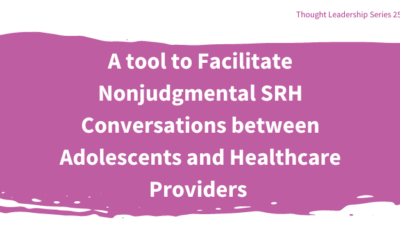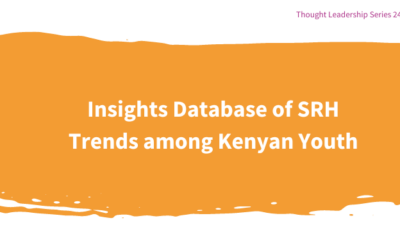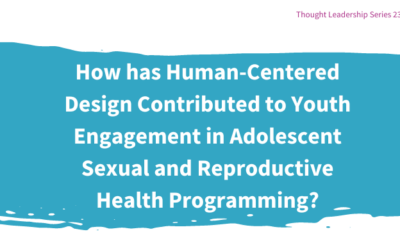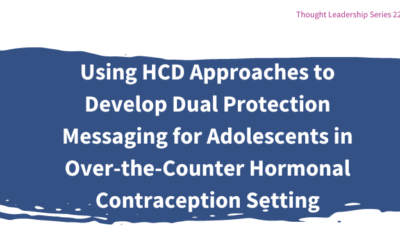By Amy Dempsey, PATH; Katharine Shelley, PATH; Thenjiwe Sisimayi, Independent Consultant; Tinovonga Mawoyo, Population Services International; Gwendoline Chapwanya, Pangaea Zimbabwe AIDS Trust; Emily Lark Harris, USAID

V Starter Kit with pill case
Nineteen-year-old Rumbi takes “V” every morning at 8AM, after she’s completed her house chores and eaten breakfast. “V” is her oral PrEP, a pill taken daily to prevent HIV infection. She never forgets to take her pill because her “V” pill case sits out on her shelf, where she can always see it. This pill case is special because it looks like a lip gloss container and is covered in the “V” branding she loves, which conceals the case’s contents.
“Without ‘V,’ I would not take PrEP… ‘V’ keeps a secret. I love to keep my secrets,” she said.
In Zimbabwe, young women like Rumbi face significant obstacles when obtaining consistent and confidential access to PrEP. Inconvenient services, family involvement, and social stigma and pressure hinder initiation and continuation of oral PrEP for HIV prevention.
“I dropped out of PrEP the first time because I feared being discovered, and then people would think of me as someone living with HIV,” Rumbi said.
With many young women unable to take charge of their own sexual and reproductive health, there is a demand for enhanced privacy, convenience, confidentiality, quality, and consistent supply of health products and services. When preparing to launch “V” in Zimbabwe, we knew that if we wanted to revolutionize oral PrEP — from a biomedical HIV prevention tool to a self-care experience — we had to engage young women and healthcare workers, not just as stakeholders, but as co-designers in all aspects of the project.
Here we reflect on “V” in Zimbabwe and share lessons from our experience using an end-to-end, human-centered design (HCD)-informed process. This end-to-end approach infused design thinking throughout the planning and execution of integrating “V” through engagements at clinics, in the community, and virtually.
These lessons, which are rooted in people and processes, could help guide future HCD projects that target young women.
Learning from people: Desire is contextual
Instead of starting from scratch, we repurposed similar HCD work from South Africa for the Zimbabwe context. Bringing young Zimbabwean women and their unique needs into focus showed our team how to give Rumbi and other young women what they really want when it comes to PrEP: a young, vibrant, and empowering experience. The insights they shared allowed the project team to translate cultural, relationship, HIV, product, and healthcare provider learnings into a self-care brand and experience rooted in design principles of delight, discretion, and empowerment:
- Delight—Encouraging a joyful association with PrEP to counter young women’s fears
- Discretion—Enabling young women to disclose their PrEP use when and how they choose
- Empowerment—Tapping into young women’s individual and collective agency to prevent HIV

Insights from young women during co-design sessions helped ensure “V” materials created a young, vibrant, and empowering experience
By designing alongside young women using these principles, oral PrEP was freed from the medical associations of an HIV prevention product originally meant for key populations like sex workers, injection drug users, and men who have sex with men, to a self-care product that fits seamlessly into the lives of young women like Rumbi and her peers.
One young woman described “V” as “V ineka that, that, that!” which translates to “in a class of its own!”
HCD is not a one-step process, it’s iterative and involves multiple phases, constant learning, and adaptation. Before implementing “V” in Zimbabwe, we sought user feedback on the materials originally developed in South Africa like clinic posters, educational flipcharts, frequently asked question (FAQ) booklets, and staff training manuals. We engaged young women for their perspective on the PrEP “starter kits” that included the “V” makeup bag, reminder sticker, FAQ guide, and a “V” pill case that holds seven pills at a time and helps young women remember to take PrEP daily.
Young women’s feedback informed whether the original materials from South Africa resonated with local contexts in Zimbabwe—urban, peri-urban, and rural settings in four districts—or if they needed to be adapted. Young women asked us to include a mix of inspirational and realistic women in Zimbabwe to reflect hairstyles, dress, and jewelry common in Zimbabwe. They also asked our team to incorporate local models to galvanize conversations about HIV prevention and PrEP, which resonated with urban and rural audiences. Lastly, adding parents, partners, and friends to posters encouraged community support.
“Create a poster that will accommodate rural girls. These images are too fancy.” – Young Woman

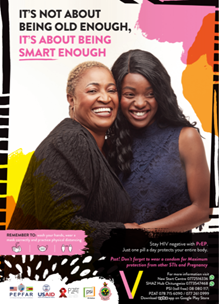
In-clinic poster developed in South Africa (left) with adolescent girls and young women advocating for taking charge of one’s health, and the in-clinic poster adapted for Zimbabwe (right) to include parents and advocate for community support for PrEP.
One principle of HCD is balancing granular and 30,000-foot views, and learning and adapting from both vantage points. We learned that a small-scale pre-pilot or “soft launch” would have been useful for testing the complete service delivery experience and all brand materials, including packaging, informational pamphlets, and health facility posters. During the first few weeks of implementation, initial feedback from young women and healthcare workers suggested small tweaks that could improve implementation and user experience. For example, promoting discretion by reducing the size of the educational pamphlet to more easily fit in the makeup bag or pocket without folding; or ensuring each healthcare provider had their own educational flip chart for sharing materials during the height of the COVID-19 pandemic.
Learning from the process: Implementation drives further iteration
During the initial three months of implementation, we interviewed young women, Brand Ambassadors, and healthcare providers to learn more about what they liked about “V” and what could be further improved about the “V” materials or how they were implemented. Early implementation confirmed that that the starter kit was universally well-loved, and also that implementers should consider modifying the makeup bag colors to limit any unintended consequences of associating PrEP with the makeup bag.
“They think that ‘V’ rocks, the starter kit is an accessory that slays and helps you stay free of HIV,” Rumbi said.

Elements of Zimbabwe’s V starter kit that were the most popular were the makeup bag and the pill case. The bag because adolescent girls and young women think it’s “beautiful,” and the pill case because, unlike a traditional pill bottle, it does not make any noise and is designed to look like a lip gloss container.
Even with a HCD-led adaptation of materials, if your end users are not engaged or effectively trained on how to use your materials, your work may not have the intended reach or impact.
The project teams at Population Services International (PSI) and Pangaea Zimbabwe AIDS Trust (PZAT) work closely with Brand Ambassadors, who serve as “PrEP champions” to generate demand for “V” among adolescent girls and young women. The Brand Ambassadors were more than co-creators, they became co-facilitators of participatory, free-flowing, open-ended “immersion” sessions, which taught our team about their motivations and barriers related to decision-making regarding initiating and adhering to PrEP. Brand Ambassadors were well versed in the design and rationale for each “V” branded material and their role in using the materials to promote demand. But when it came time to launch “V”, the implementation context shifted due to COVID-19 and our training materials and approach needed time to catch up.
Training is vital and it takes time. Ensuring enough time to cover all content and checking in regularly through refresher training can enhance knowledge retention and can get you closer to your desired impact. On reflection, our project team would have built more time for refresher training and check-ins with Brand Ambassadors and healthcare workers to make sure they had a shared understanding of their roles in implementing “V”.

Brand Ambassadors and healthcare workers proudly showcasing “V” materials during a training session
The COVID-19 pandemic delayed our launch timeline and also forced a reimagining of the planned in-person “V” parties with young women, which transitioned to virtual sessions using WhatsApp, allowing Brand Ambassadors to continue the work safely and reach underrepresented young women in remote locations. In the context of the COVID-19 pandemic, a switch to virtual training required more resources to develop training content and to cover data costs for online participation, but they also eliminated travel times and related travel expenses for young women. We needed to rethink some of the implementation approaches, such as designing additional training for Brand Ambassadors in how to manage and facilitate online discussion groups—we are still iterating on how to do this most efficiently and effectively!
Conclusions on scaling up with HCD
The year-long “V” pilot in Zimbabwe will continue implementation through 2022, but the early implementation learnings demonstrate the impact HCD can have in global health, specifically when it comes to enhancing Rumbi’s and other young women’s ability to take charge of their own sexual and reproductive health through self-care solutions that fit their unique needs and lifestyles.
The original service delivery strategy for “V” in South Africa integrated financing and marketing techniques commonly found in the private sector, such as leveraging the commercial brand appeal of “V” by offering it in private sector pharmacies. Due to the scale of the pilot program in Zimbabwe, approaches to leveraging private sector pharmacies were not included. Stakeholders recognized pharmacies as a key referral channel for potential PrEP users, and agreed that pharmacies could be an opportunity for future scale-up by serving as a retail channel for the “V” starter kits, complementing opportunities for expansion in the public sector (read here to learn about how “V” informed such an approach in Lesotho). The “V” experience demonstrates how drawing solutions from public and private sectors can spark innovation in product design, program delivery, and funding models – critical to the uptake of HIV prevention products like oral PrEP – and shows the potential of HCD to co-design innovative solutions that merge these public and private sector mindsets.
V Zimbabwe was created in collaboration with adolescent girls and young women, healthcare workers and a global network of partners led by EngageDesign – a human-centered design partnership including Matchboxology and PATH – alongside PSI Zimbabwe, Pangaea Zimbabwe AIDS Trust, and the Zimbabwe Ministry of Health and Child Care. V Zimbabwe is infused with the spirit of EMOTION, a CONRAD-led partnership with IDEO, Matchboxology, Abt Associates, CAPRISA, and Instant Grass, that launched V (https://www.conrad.org/launchingv/).
V Zimbabwe was made possible by the support of the American people through the United States Agency for International Development (USAID) under the U.S. President’s Emergency Plan for AIDS Relief (PEPFAR) through EngageDesign contract 7200AA18M00011 and EMOTION Cooperative Agreement AID-OAA-A-15-00033. V is a registered trademark of CONRAD. The content of this blog is solely the responsibility of the authors and does not necessarily represent the official views of USAID, or any other agency.

